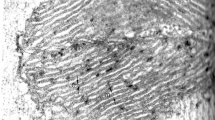Summary
Glucose utilization by the isolated rat heart is restricted by flux through the membrane transport, phosphofructokinase and glyceraldehyde-3-P dehydrogenase reactions. These reactions can be accelerated by hormones, such as insulin, by mechanical factors, such as the “garden-hose effect”, heart rate, and perhaps ventricular pressure development, and by oxygen deprivation. Glucose utilization is restricted by provision of exogenous non-carbohydrate substrates and by utilization of endogenous substrate stores. Isolated hearts perfused as Langendorff preparations with or without a ventricular drain, working hearts, and ischemic preparations are useful in defining rate-limiting steps and mechanisms of regulation. However, when glucose is supplied as the sole exogenous substrate, its rates of utilization do not reflect the more complexin vivo situation where competing substrates such as fatty acids are preferentially utilized.
Similar content being viewed by others
References
Neely JR, Morgan HE (1974) Relationship between carbohydrate and lipid metabolism and the energy balance of heart muscle. Ann Rev Physiol 36:413
Morgan HE, Henderson MJ, Regen DM, Park CR (1961) Regulation of glucose uptake in muscle. I. The effects of insulin and anoxia on glucose transport and phosphorylation in the isolated, perfused heart of normal rats. J Biol Chem 236:253
Flaim KE, Kochel PJ, Kira Y, Kobayashi K, Fossel ET, Jefferson LS, Morgan HE (1983) Insulin effects on protein synthesis are independent of glucose and energy metabolism. Am J Physiol 245:C133
Clark MG, Patten GS, Filsell OH (1982) Evidence for an α-adrenergic receptor-mediated control of energy production in heart. J Mol Cell Cardiol 14:313
Williamson JR (1966) Glycolytic control mechanisms. II. Kinetics of intermediate changes during the aerobic-anoxic transition in perfused rat heart. J Biol Chem 214:5026
Kobayashi K, Neely JR (1979) Control of maximum rates of glycolysis in rat cardiac muscle. Circ Res 44:166
LaNoue K, Nicklas WJ, Williamson JR (1970) Control of citric acid cycle activity in rat heart mitochondria. J Biol Chem 245:102
Rovetto MJ, Lamberton WF, Neely JR (1975) Mechanisms of glycolytic inhibition in ischemic rat hearts. Circ Res 37:742
Randle PJ, Newsholme EA, Garland PB (1964) Regulation of glucose uptake by muscle. 8. Effects of fatty acids, ketone bodies and pyruvate, and of alloxan diabetes and starvation, on the uptake and metabolic fate of glucose in rat heart and diaphragm muscle. Biochem J 93:652
Neely JR, Bowman RH, Morgan HE (1969) Effects of ventricular pressure development and palmitate on glucose transport. Am J Physiol 216:804
Kao R, Rannels DE, Morgan HE (1976) Effects of anoxia and ischemia on protein synthesis in perfused rat hearts. Circ Res 38, Suppl I, I-124
Neely JR, Liebermeister H, Battersby EJ, Morgan HE (1967) Effect of pressure development on oxygen consumption by isolated rat heart. Am J Physiol 212:804
Rubányi G, Kovách AGB (1980) The role of coronary perfusion pressure in the control of mechanical performance and oxygen consumption in the isolated rat heart. Acta Physiol Acad Scient Hungaricae 55:189
Opie LH (1965) Coronary flow rate and perfusion pressure as determinants of mechanical function and oxidative metabolism of isolated perfused rat heart. J Physiol 180:529
Taeghtmeyer H, Hems R, Krebs HA (1980) Utilization of energy-providing substrates in the isolated working rat heart. Biochem J 186:701
Gregg DE (1963) Effect of coronary perfusion pressure or coronary flow on oxygen usage of the myocardium. Circ Res 13:497
Arnold G, Kosche F, Miessner E, Neitzert A, Lochner W (1968) The importance of the perfusion pressure in the coronary arteries for the contractility and oxygen consumption of the heart. Pflügers Archiv 299:339
Opie LH, Mansford KRL, Owen P (1971) Effects of increased heart work on glycolysis and adenine nucleotides in the perfused heart of normal and diabetic rats. Biochem J 124:475
Neely JR, Whitmer KM, Mochizuki S (1976) Effects of mechanical activity and hormones on myocardial glucose and fatty acid utilization. Circ Res 38:Suppl I, I-22
Neely JR, Rovetto MJ, Whitmer JT, Morgan HE (1973) Effects of ischemia on ventricular function and metabolism in the isolated working rat heart. Am J Physiol 225:651
de Leiris J, Opie LH, Lubbe WF (1975) Effects of free fatty acids and glucose on enzyme release in experimental myocardial infarction. Nature (London) 253:746
Cheung JY, Conover C, Regen DM, Whitfield CF, Morgan HE (1978) Effect of insulin on kinetics of glucose transport in heart muscle. Am J Physiol 234:E70
Neely JR, Liebermeister H, Morgan HE (1967) Effect of pressure development on membrane transport of glucose in isolated rat heart. Am J Physiol 212:815
Rubányi G, Kovách AGB (1980) The role of calcium ions in the control of myocardial mechanical performance and oxygen consumption by coronary perfusion pressure. Acta Physiol Acad Scient Hungaricae 55:197
Kira Y, Kochel P, Gordon EE, Morgan HE (in press) Aortic perfusion pressure as a determinant of cardiac protein synthesis. Am J Physiol
Salisbury PF, Cross CE, Rieben PA (1960) Influence of coronary artery pressure upon myocardial elasticity. Circ Res 8:794
Vogel WM, Apstein CS, Briggs LL, Gaash WH, Ahn J (1982) Acute alterations in left ventricular diastolic chamber stiffness. Role of the “erectile” effect of coronary arterial pressure and flow in normal and damaged hearts. Circ Res 51:465
Morgan HE, Randle PJ, Regen DM (1959) Regulation of glucose uptake by muscle. 3. The effects of insulin, anoxia, salicylate and 2∶4-dinitrophenol on membrane transport and intracellular phosphorylation of glucose in the isolated rat heart. Biochem J 73:573
Author information
Authors and Affiliations
Rights and permissions
About this article
Cite this article
Morgan, H.E., Neely, J.R. & Kira, Y. Factors determining the utilization of glucose in isolated rat hearts. Basic Res Cardiol 79, 292–299 (1984). https://doi.org/10.1007/BF01908029
Received:
Issue Date:
DOI: https://doi.org/10.1007/BF01908029




